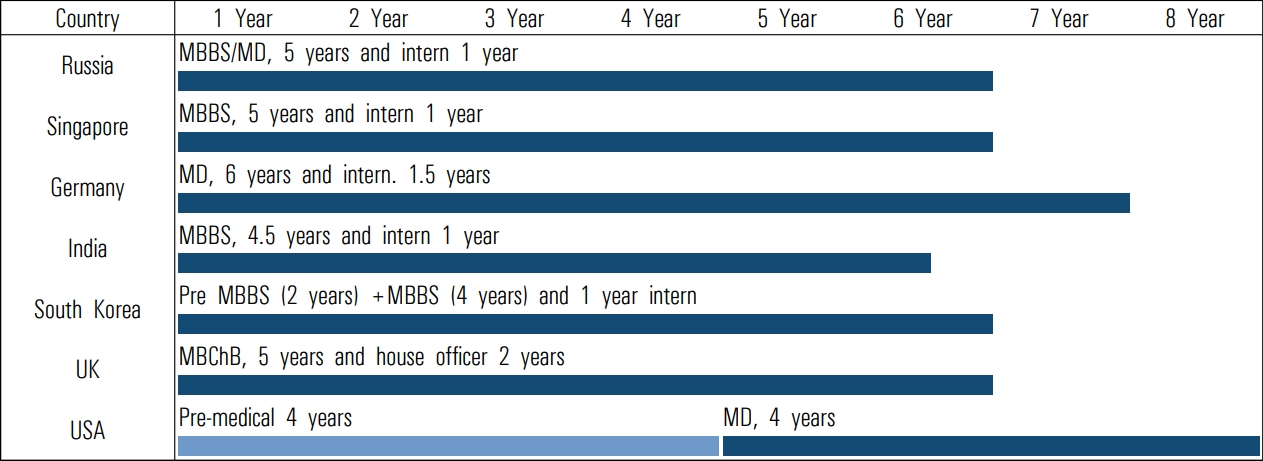Medicine is considered as the noblest profession on this planet, and to make a noble professional in medicine, there are multiple steps followed throughout the world by the academic and professional regulatory bodies. Universities worldwide integrate the values and spirit of medical education by teaching, learning, and understanding various commitments and ethics of professionalism during practice, and research through their respective medical curriculum.
An authority or council in each country separately regulates the medical teaching curriculum, training, and professional practices. In India, it is the National Medical Commission; in the United Kingdom, it is the General Medical Council, in Singapore, it is the Singapore Medical Council; and similarly in the United States, it is the Liaison Committee on Medical Education, and so forth.
From the perspective of global health issues, most of diseases have no geographical boundaries and are found almost worldwide [1]. This was further confirmed during coronavirus disease 2019 pandemic when one virus put entire humanity under the threat of extinction! But a united and spirited fight against this virus by world healthcare professionals and scientists can save humanity. Further, we must agree that healthcare training for medical professionals needs a universal approach with formal learning and training; hence, medical education, including specialty or super specialty education, must be adopted by a standard medical teaching and training program worldwide. Typical medical teaching-learning objectives, training, and professional practices for medical students from an early stage of their career to the specialty doctors in every country are the need of the hour [2]. Standard training during the making of a “doctor” is expected to be uniform in all countries by, not only in “curriculum aspects” but also the “duration aspects” of each curriculum and training worldwide [3]. Even a uniform quantity and quality of the medical teacher for each medical teaching and training program are also expected for the entire world. Suppose the objective of a medical professional is to serve a patient; in that case, the teaching and training need to be equal not only through the process by acquiring common knowledge under the “curriculum” but also having a common “duration” for each of the curriculum and training.
But the irony is that when one thinks of the “duration” of medical teaching and training period from a global perspective, one will be surprised to know about international variations of teaching, learning, and training “duration” among nations! Hence the global uniformity of competency among doctors is questioned when their learning, gaining skills and training duration to become a professionally competent doctor or specialty doctor are different!
The actual duration for making a professionally qualified and licentiate primary doctor in some nations can be found in Fig. 1.
Fig. 1 shows the most extended duration to become a medical graduate after a high school program (12 years) is in the United States, i.e., 4 years of undergraduate program like B.A. (Bachelor of Arts) or B.S. (Bachelor of Science) followed by 4 years in a medical program with a total 8 years duration, while in India is having the shortest duration to be a medical graduate after high school (12 years), i.e., 4 years and 6 months for the medical undergraduate program and 1 year for training as internship with total 5 and half years duration after high school education (12 years). The medical graduate program in India, Singapore, South Korea, or the United Kingdom; the academic basic degree of medicine is M.B.B.S. or M.B.Ch.B. (Bachelor of Medicine, Bachelor of Surgery), whereas in the case of the United States, the degree is M.D. (Doctor of Medicine). In Russia, both M.B.B.S. and M.D. degrees are considered for basic medical programs depending upon the specific university [4].
Fig. 2 shows the global scenario of the training duration of medical specialty doctors. Medical specialty doctors are being trained in different formats like postgraduate or super specialist training or simply as residency in specialty training.
It is clear from Fig. 2 that Germany and the United Kingdom have the longest (4-8 years) medical specialty training or residency period after medical graduation, while India and South Korea have the shortest (3 years) of postgraduation or specialty teaching/residency period. Results also showed Russia too has a short duration (2-4 years) of specialty/residency training. In the case of India, residency includes a postgraduate medical curriculum like M.D. or M.S. (Master of Surgery) or D.N.B. (Diplomate of National Board), and so forth. Indian medical super specialty education/training provides D.M. (Doctorate of Medicine) and M.Ch. (Master of Chirurgiae) besides D.N.B. (super specialty). In Singapore, the residency includes an M.Med (Master of Medicine) and a fellowship curriculum. In the United Kingdom, besides the residency period after graduation (M.B.Ch.B.) there are medical; specialties curricula like MRCP (Membership of the Royal Colleges of Physicians), MRCS (Membership of the Royal Colleges of Surgeons), and so forth under the Royal Colleges of Physicians and Surgeons [5].
In view of these larger variations of medical teaching and training duration among different countries in the world, it may definitely remain a question of uniform competency among medical graduates! Further, there may also be questions about whether the variation of duration in medical education and training in different countries matters or not for uniform global medical education and training competency. In spite of the shortest duration of medical education and training, Indian medical graduates successfully clear the United States Medical Licensing Examination or Professional and Linguistic Assessments Board every year and establish them as competent medical professionals in the United States, United Kingdom, or Australia like developed countries.














